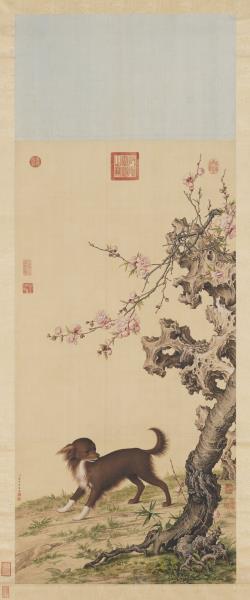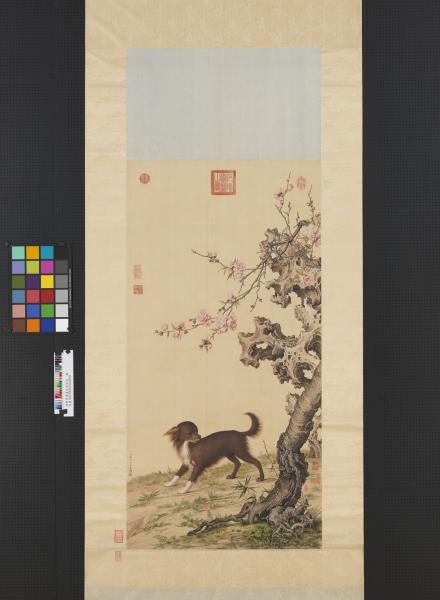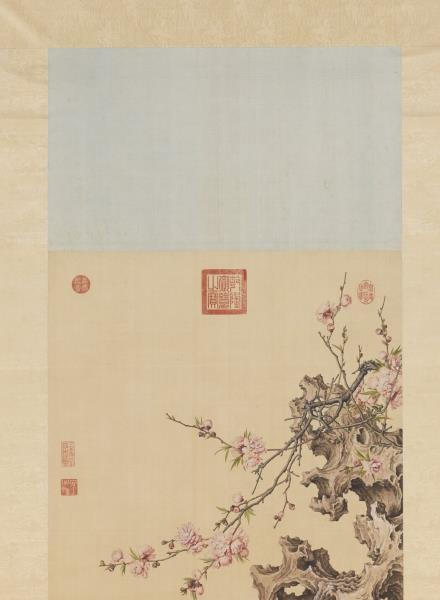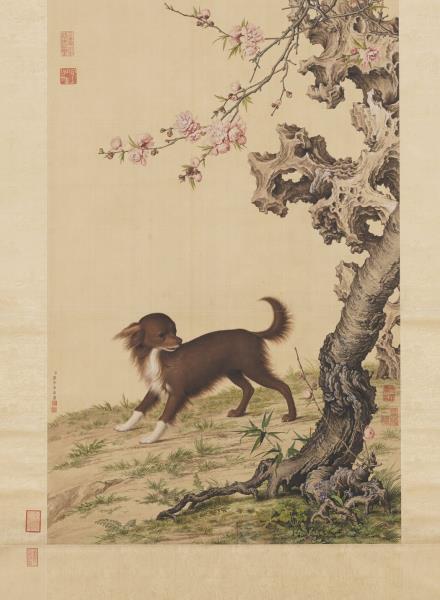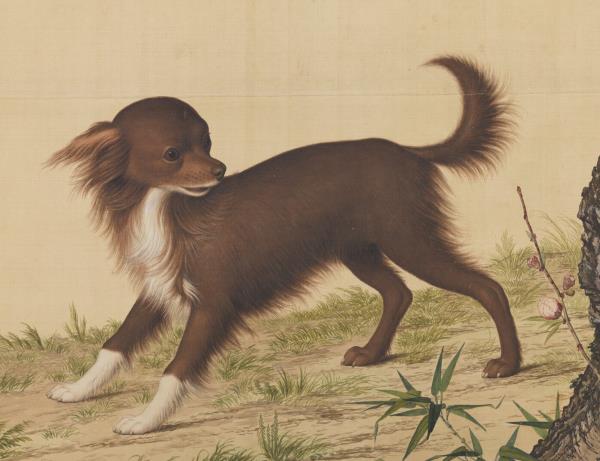| 文物統一編號 |
故畫000798N000000000
|
| 作品號 |
故畫00079800000 |
| 品名 |
清郎世寧畫花底仙尨 軸
Sylphine Long-haired Dog Beneath the Flowers |
| 分類 |
繪畫 |
| 作者 |
郎世寧,Lang Shining,Giuseppe Castiglione |
| 數量 |
一軸 |
| 位置 |
尺寸(公分) |
| 本幅 |
123.2x61.9 |
| 地綾(白) |
12x89 |
| 邊綾 |
13x123.2 |
| 天綾(白) |
19.4x89 |
| 全幅 |
238x89 |
| 地綾(藍) |
36x89 |
| 天綾(藍) |
57.6x89 |
| 印記類別 |
印主 |
印記 |
| 鑑藏寶璽 |
清內府印 |
三希堂精鑑璽 |
| 鑑藏寶璽 |
清內府印 |
石渠寶笈 |
| 鑑藏寶璽 |
清內府印 |
宜子孫 |
| 鑑藏寶璽 |
清高宗 |
乾隆御覽之寶 |
| 鑑藏寶璽 |
清仁宗 |
嘉慶御覽之寶 |
| 鑑藏寶璽 |
清仁宗 |
嘉慶鑑賞 |
| 鑑藏寶璽 |
清仁宗 |
寶笈三編 |
| 主題類別 |
主題(第一層) |
主題(第二層) |
主題說明 |
| 主要主題 |
走獸 |
狗 |
|
| 主要主題 |
花草 |
碧桃花 |
|
| 次要主題 |
山水 |
奇石 |
|
| 其他主題 |
樹木 |
竹 |
|
| 類別 |
參考資料 |
| 內容簡介 |
湖石旁的桃花正盛開,樹下一隻棗紅色的小狗,前腿與胸部為白色,尾巴翹起,頭略側向後方,似乎正在行進之中被其他事物、聲音吸引而停下張望,模樣十分可愛。湖石、樹幹等也都是以光影變化來處理質面凹凸,小狗眼睛上的光影與毛色光澤都有接近西洋光影處理的表現特色。畫上雖沒有紀年,但在雍正五年(1727)檔案中記錄著郎世寧畫有「者爾得」小狗,「者爾得」滿文意棗紅色,或許就是此幅。
|
| 內容簡介 |
郎世寧(西元一六八八-一七六六年),意大利人。十九歲時,入天主教耶穌會為修士。曾習油畫,兼習建築。二十七歲來華傳教,以繪事供奉內廷。歷仕康熙雍正、乾隆三朝。畫法參酌中西,善畫人物花鳥,尤擅犬馬。 此幀畫碧桃湖石,一隻褐色馴犬徘徊其間。全作使用西洋顏料,設色穠艷。繪製以西法為主,注重光影透視之表現,犬足立處尚繪陰影,景物細緻逼真。
|
| Description |
Lang Shih-ning is the Chinese name of the Italian Giuseppe Castiglione. At 19, he entered the Jesuit order and studied oil painting and architecture. At 27, he arrived in China as a missionary and later served the court as a painter. He combined Chinese and Western techniques, excelling at figures and birds-and flowers, especially dogs and horses. This painting represents a little brown dog between a flowering peach tree and a fantastic garden rock. The coloring scheme is Western, creating an opulent effect. Done mostly with Western techniques, chiaroscuro and perspective are emphasized. The shadows cast by the paws reveal the degree of realism.
|
| Description |
Next to a decorative garden lake rock is a peach tree shown in full bloom, below which is a small dog that is date-red in color with a white chest and forelegs. With its tail curved up and head turned back, it seems to have stopped in the midst of running to look at something it has heard or has caught its attention. The appearance of the dog is indeed quite endearing. Variations of shadows on the rock and tree trunk emphasize the uneven texture of their surfaces, and the reflection in the eyes of the dog and luster of its fur also closely reflect the special effects of light found in Western art. Although this work is undated, a record from 1727 in the Yung-cheng reign (1723-1735) indicates that Giuseppe Castiglione painted a small dog with a Manchurian name translated as “Date Red.” Perhaps this is the painting found in that record.
|
| 網頁展示說明 |
郎世寧(Giuseppe Castiglione,1688-1766),意大利米蘭人。十九歲時,入天主教耶穌會為修士。曾習油畫,兼習建築。康熙五十四年(1715)來華傳教,抵澳門後,先學習中國語言和生活習慣,並且取了中國名字──郎世寧。因為他卓越的繪畫技法,供奉內廷,歷仕康熙、雍正、乾隆三朝。他善畫人物、花鳥,更長於畫犬馬。
郎世寧來華以前,已具西洋繪畫素養,故早期畫作大多以西法為主。供職內廷後,又潛心學習中國繪畫,逐漸形成中西合璧的嶄新畫風。這件畫軸畫碧桃湖石,一隻褐色馴犬徘徊其間。全作使用西洋顏料,色彩穠艷。特別註重光影明暗的變化和透視的表現,褐犬的四足及桃樹的樹根都繪陰影,樹石、動物形像肖似逼真。畫幅右下方有郎氏款署,是以仿宋字體落款。這些都與郎氏早期繪畫的特徵相侔合,故推測這件畫軸是郎氏入華後的早期作品。
|
| 網頁展示說明 |
Lang Shih-ning was the Chinese name of the Italian Giuseppe Castiglione, a native of Milan. At the age of 19, he entered the Jesuit order as a novitiate and studied oil painting and architecture. In 1715, he arrived in China as a missionary. After landing in Macao, he studied Chinese and learned about Chinese customs and culture, taking a Chinese name in the process. Due to his skills in painting, he came to serve the inner court under the emperors K'ang-hsi (r. 1662-1722), Yung-cheng (r. 1723-1735), and Ch'ien-lung (r. 1736-1795). Giuseppe Castiglione excelled at painting figures and birds-and-flowers, especially dogs and horses.
Since Castiglione had studied Western painting before coming to China, his early works were done with Western techniques. After entering service in the inner court, however, he set upon the study of Chinese painting and gradually formed a new style that synthesized aspects of both Western and Chinese painting. This painting represents a little brown dog between a flowering peach tree and an ornamental garden rock. The coloring scheme is Western overall and has an opulent effect. Done mostly with Western techniques, chiaroscuro (shading to represent the effect of light) and perspective are emphasized. Shadows, for example, appear cast by the tree trunk and the paws of the dog. So realistic, in fact, are the tree, rock, and dog that they appear as if painted after actual subjects. In the lower left corner is Castiglione's signature in Chinese done with Sung-style script. These are all features consistent with his early paintings, so it appears that this is an early work done not long after his arrival in China.
|
| 參考書目 |
陳韻如,〈清郎世寧畫花底仙尨 軸〉,收入何傳馨主編《神筆丹青-郎世寧來華三百年特展》(臺北:國立故宮博物院,2015.10),頁30-33、406。
|
| 參考書目 |
馮明珠,〈清郎世寧畫花底仙尨 軸〉,收入《雍正-清世宗文物大展》(臺北:國立故宮博物院,2009.09),頁322-323。
|
| 收藏著錄 |
石渠寶笈三編(寧壽宮),第七冊,頁3471
|
| 收藏著錄 |
故宮書畫錄(卷五),第三冊,頁573
|
| 收藏著錄 |
故宮書畫圖錄,第十四冊,頁39-40
|
| 參考書目 |
1.王耀庭、陳韻如,〈清郎世寧畫花底仙尨〉,收入王耀庭主編,《新視界 : 郎世寧與清宮西洋風》(臺北:國立故宮博物院,2007年初版),頁52-53。
2.韓北新,〈郎世寧繪畫繫年(六)〉,《故宮文物月刊》,第72期(1989年3月),頁50-51。
3.林莉娜,〈清 郎世寧 畫花底仙尨圖〉,收入馮明珠主編,《雍正—清世宗文物大展》(臺北:國立故宮博物院,2009年九月初版一刷),頁323。
|
本院文物保存維護依〈國立故宮博物院典藏文物管理作業要點〉及〈國立故宮博物院文物修護業務作業原則〉辦理
抽盤點紀錄
修護紀錄

